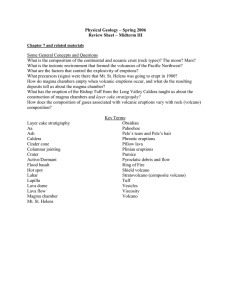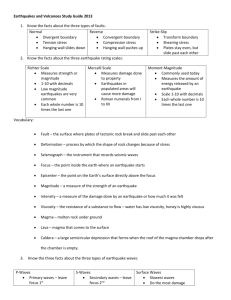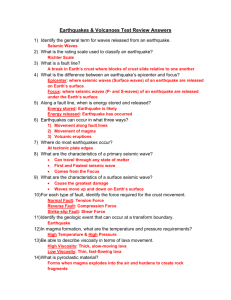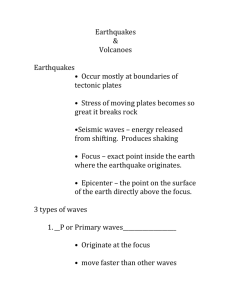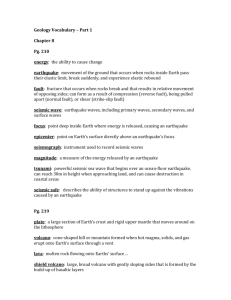Study Guide – Earthquakes and Volcanoes Test
advertisement
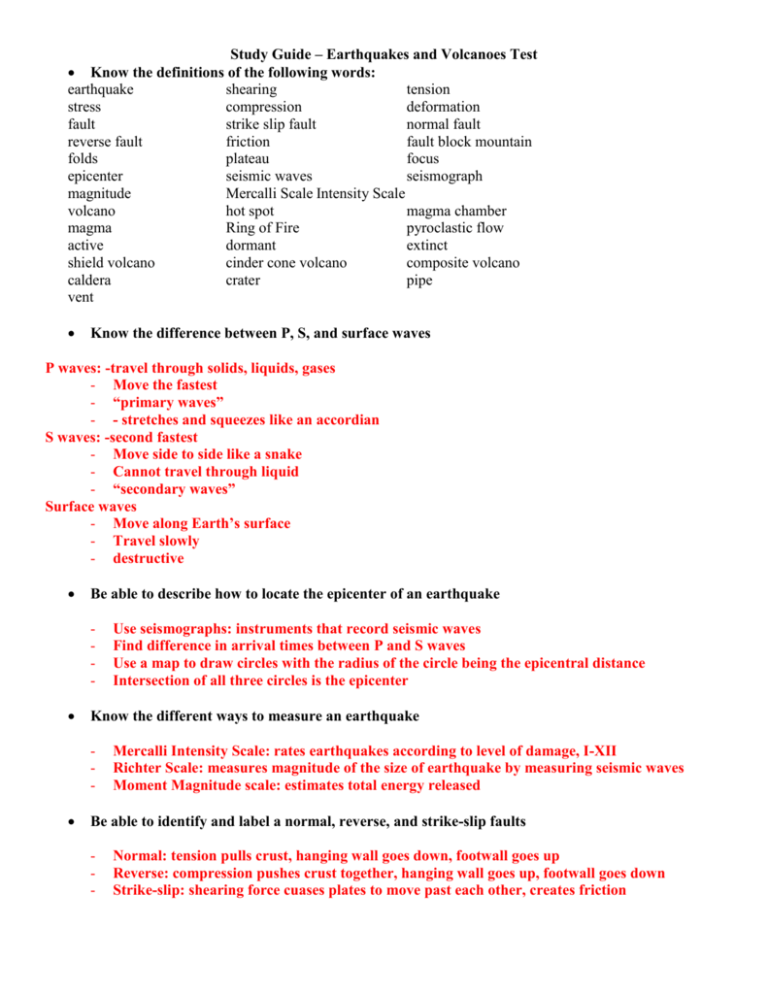
Study Guide – Earthquakes and Volcanoes Test Know the definitions of the following words: earthquake shearing tension stress compression deformation fault strike slip fault normal fault reverse fault friction fault block mountain folds plateau focus epicenter seismic waves seismograph magnitude Mercalli Scale Intensity Scale volcano hot spot magma chamber magma Ring of Fire pyroclastic flow active dormant extinct shield volcano cinder cone volcano composite volcano caldera crater pipe vent Know the difference between P, S, and surface waves P waves: -travel through solids, liquids, gases - Move the fastest - “primary waves” - - stretches and squeezes like an accordian S waves: -second fastest - Move side to side like a snake - Cannot travel through liquid - “secondary waves” Surface waves - Move along Earth’s surface - Travel slowly - destructive Be able to describe how to locate the epicenter of an earthquake - Know the different ways to measure an earthquake - Use seismographs: instruments that record seismic waves Find difference in arrival times between P and S waves Use a map to draw circles with the radius of the circle being the epicentral distance Intersection of all three circles is the epicenter Mercalli Intensity Scale: rates earthquakes according to level of damage, I-XII Richter Scale: measures magnitude of the size of earthquake by measuring seismic waves Moment Magnitude scale: estimates total energy released Be able to identify and label a normal, reverse, and strike-slip faults - Normal: tension pulls crust, hanging wall goes down, footwall goes up Reverse: compression pushes crust together, hanging wall goes up, footwall goes down Strike-slip: shearing force cuases plates to move past each other, creates friction Be able to name, describe, and label basic features of a volcano (magma chamber, pipe, vent, crater, lava flow) Crater Vent Lava Flow Pipe Magma Chamber Explain the type of stress and faults that accompany a divergent, convergent, and transform boundaries. - Divergent: tension, normal fault - Convergent: compression, reverse fault - Transform: Shear, strike-slip fault Explain how a shield, cinder cone, and composite volcanoes are alike and different. - Shield: wide, gently sloping sides, quiet eruptions - Cinder Cone: steep, cone-shaped hill, made of pyroclastic materials, explosive eruptions, small - Composite: tall, cone-shaped, explosive followed by quiet eruptions Explain how volcanos effect climate and surface changes. - Gases and ash go into atmosphere, block’s sunlight, global temperatures drop. Explain types of lava flow and types of eruptions - Aa: pours out fast, forms brittle crust Pahoehoe: flows slowly, round and wrinkly Pillow: underwater, rounded lumps Blocky: oozes, cool and stiff, stays near Explosive: high in silica, high viscosity, think/sticky - Can build up in pipe and explode Quiet eruptions/non-explosive - Low silica, low viscosity, flows easily, oozes out quietly, buries everything, Hawaii Explain the properties of magma Viscosity: resistance of liquid to flow - High – think, flows slowly, sticky - Depends on silica content: high silica = higher viscosity, low silica = low viscosity Explain the similarities and differences of a hot spot, volcanic belt, and island arcs Hot spot - Magma melts through crust, found in middle of plates or along plate boundaries, volcanoes form above hot spot Volcanic Belt - Forms along plate boundaries - Many volcanoes from divergent or convergent boundary - Ring of Fire: major volcanic arc in Pacific Ocean Island Arcs - String of volcanic islands - Formed from subduction at converging oceanic plates
